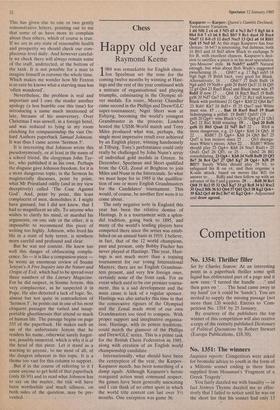Chess
Happy old year
Raymond Keene
1 984 was remarkable for English chess. IJon Speelman set the tone for the coming twelve months by winning at Hast- ings and the rest of the year continued with a mixture of organisational and playing triumphs, culminating in the Olympic sil- ver medals. En route, Murray Chandler came second in the Phillips and Drew/GLC super-tournament; Nigel Short won at Esbjerg, becoming the world's youngest Grandmaster in the process; London hosted the USSR-World match and Tony Miles produced what was, perhaps, the single most impressive result ever achieved by an English player, winning handsomely at Tilburg. Tony's performance could only really be challenged by John Nunn's array of individual gold medals in Greece. In December, Speelman and Short qualified from the CGL Zonal at Brighton to join Miles and Nunn in the Interzonals. So what we must hope for in 1985 is the qualifica- tion of one or more English Grandmasters for the Candidates' tournament. This would, of course, be another first were it to come about.
The only negative note in England this year has been the relative demise of Hastings. It is a tournament with a splen- did, tradition, going back to 1895, and many of the world's leading players have competed there since the series was estab- lished on an annual basis in 1919. I believe, in fact, that of the 12 world champions, past and present, only Bobby Fischer has never played at Hastings. This year, Hast- ings is not much more than a training tournament for our young International Masters; there are no English Grandmas- ters present, and very few foreign ones, certainly none of the front rank. For an event which used to be our premier tourna- ment, this is a sad development and the main cause is lack of a regular sponsor. Hastings was also unlucky this time in that the consecutive rigours of the Olympiad and the Zonal made most of our own Grandmasters too tired to compete. With proper support and imaginative organisa- tion, Hastings, with its potent traditions, could match the glamour of the Phillips and Drew/GLC series. This is a prime task for the British Chess Federation in 1985, along with creation of an English world championship candidate.
Internationally, what should have been the centrepiece of the year, the Karpov- Kasparov match, has been something of a damp squib. Although Kasparov's heroic rearguard action must command respect, the games have been generally unexciting and I can think of no other sport in which the world title contest can last over 31/2 months. One exception was game 36:
Kasparov — Karpov: Queen's Gambit Declined, Tartokower Variation.
1 d4 Nf6 2 c4 e6 3 Nf3 d5 4 Nc3 Be7 5 Bg5 h6 6 Bh4 0-0 7 e3 b6 8 Be2 Bb7 9 Rd l dxc4 10 Bxc4 Nbd7 11 0-0 c5 12 dxc5 Nxc5 13 Qe2 a6 14 Rfdl Qe8 15 Ne5 b5 At this stage Kasparov has four choices: 16 b4!? is interesting, but dubious; both 16 Bb3 and 16 Bd3 allow Black to exchange N for B, with excellent chances. Kasparov's deci- sion to sacrifice a piece is in his most speculative 'pre-Moscow' style. 16 Nxb5!? axb5?! Natural enough, but what about Bob Wade's suggested zwischenzug 16 . . Qb8!? e.g. 17 Bg3 axb5 18 N56 ficg6 19 Bxb8 bxc4, very good for Black. Alternatively, 16 . . . Qb8!? 17 Bxf6 Bxf6 18 Ng4 axb5 19 Nxf6+ gicf6 20 Bxb5 Qe5! 21 f4 0f5 22 g4 0e4 23 Ftxc5 Rxa2 and Black must win. 17 Bxb5 If now 17 . . Qb8 18 Rxc5 Bxc5 19 Bxf6 gicf6 20 Nd7 Qa7 (20. . . Qc7 21 Rd l still leaves Black with problems) 21 Qg4+ Kh8 22 0h4 Be7 23 Rd4! Kh7 24 Bd3+ f5 25 Qxe7 and White must win. 17 . . . Ba6 18 Rxc5 Bxc5 19 Bxa6 Sidestepping a pitfall: 19 Bxf6? Qxb5! (19 . . . fpcf6 20 Qg4+ wins Black's Q) 20 Qg4 g5 21 Qh3 Qe2 22 Ral Rfd8 winning. 19. . . Qa4 20 Bxf6 gxf6 21 Bb5 Qxa6 22 Nd7 Be7 22 . . . Rfc8 is more dangerous, e.g. 23 Qg4+ Kh8 24 Qh5. If 22 . . . 'Rfd8!? 23 Qg4+ Kh8 24 Qh5 Be7 25 Qxf7 is less incisive since 25 . . . Qb3 disorga- nises White's pieces. After 22. . . Rfd8!? White should play 23 0g4+ Kh8 24 Nxc5 Rxd1+ 25 Qxdl Qa5 26 Qf3, or 25 . . . Qxb2 26 Bfl consolidating. 23 Qg4+ Kh8 24 Nxf8 Bxf8 25 Qf3 Be7 26 Bc4 Qa7 27 Qh5 Kg7 28 Qg4+ Kf8 29 Bfl?! Surely White should play 29 b3, to safeguard his B on c4, and then organise a K-side attack, based on moves like Rfl (in answer to . . . Rd8) and then follow up with an advance of the f and g pawns. 29. . . Rd8 30 Rdl Qb8 31 Rc2 f5 32 Qe2 Kg7 33 g3 Rc8 34 h3 Ibtc2 35 Qxc2 Bf6 36 b3 Qb4 37 Qdl Qc3 38 Kg2 Qc6+ 39 Kh2 Qc5 40 Be2 Be7 41 Kg2 Qc6+ Adjourned and draw agreed.






































 Previous page
Previous page